初中英语二年级下学期unit-4新目标
- 格式:pdf
- 大小:1.40 MB
- 文档页数:10
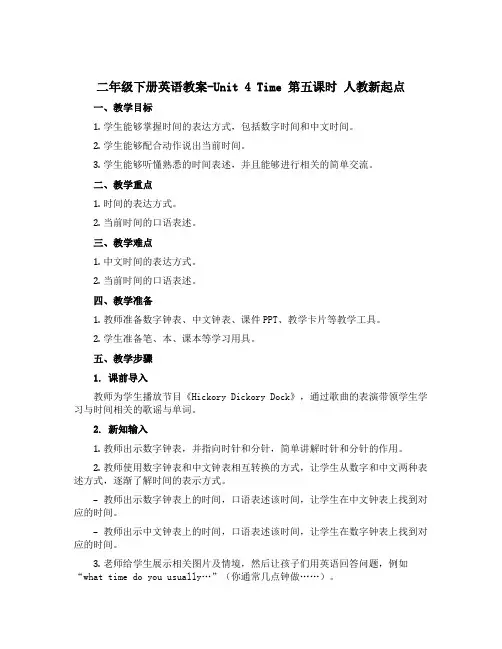
二年级下册英语教案-Unit 4 Time 第五课时人教新起点一、教学目标1.学生能够掌握时间的表达方式,包括数字时间和中文时间。
2.学生能够配合动作说出当前时间。
3.学生能够听懂熟悉的时间表述,并且能够进行相关的简单交流。
二、教学重点1.时间的表达方式。
2.当前时间的口语表述。
三、教学难点1.中文时间的表达方式。
2.当前时间的口语表述。
四、教学准备1.教师准备数字钟表、中文钟表、课件PPT、教学卡片等教学工具。
2.学生准备笔、本、课本等学习用具。
五、教学步骤1. 课前导入教师为学生播放节目《Hickory Dickory Dock》,通过歌曲的表演带领学生学习与时间相关的歌谣与单词。
2. 新知输入1.教师出示数字钟表,并指向时针和分针,简单讲解时针和分针的作用。
2.教师使用数字钟表和中文钟表相互转换的方式,让学生从数字和中文两种表述方式,逐渐了解时间的表示方式。
–教师出示数字钟表上的时间,口语表述该时间,让学生在中文钟表上找到对应的时间。
–教师出示中文钟表上的时间,口语表述该时间,让学生在数字钟表上找到对应的时间。
3.老师给学生展示相关图片及情境,然后让孩子们用英语回答问题,例如“what time do you usually…”(你通常几点钟做……)。
3. 语言输出1.让学生跟读教师发音,并练习自行用英语说出几点钟的表述方式。
2.教师设置情境,询问学生当前的时间,并让学生尝试通过、查看数字和中文钟表的方式来回答问题。
3.教师出示一些熟悉的时间表述,如“breakfast time”、“lunch time”等,让学生通过口语表达自己期待该时间发生的事情。
4. 巩固练习1.教师准备一些时间卡片,让学生配合卡片上的时间来口语表述当前的时间。
2.学生根据自己的生活习惯,在教师布置的任务要求下,练习描述日常活动时间的表述。
5. 课后作业1.诵读本课时的重点单词和相关表述。
2.在生活中多关注时间,尝试用英文表达时间。
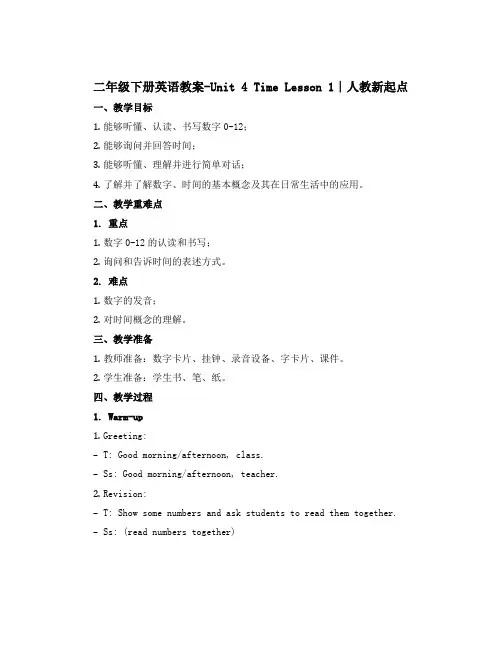
二年级下册英语教案-Unit 4 Time Lesson 1∣人教新起点一、教学目标1.能够听懂、认读、书写数字0-12;2.能够询问并回答时间;3.能够听懂、理解并进行简单对话;4.了解并了解数字、时间的基本概念及其在日常生活中的应用。
二、教学重难点1. 重点1.数字0-12的认读和书写;2.询问和告诉时间的表述方式。
2. 难点1.数字的发音;2.对时间概念的理解。
三、教学准备1.教师准备:数字卡片、挂钟、录音设备、字卡片、课件。
2.学生准备:学生书、笔、纸。
四、教学过程1. Warm-up1.Greeting:–T: Good morning/afternoon, class.–Ss: Good morning/afternoon, teacher.2.Revision:–T: Show some numbers and ask students to read them together.–Ss: (read numbers together)2. Presentation1.T: Introduce numbers 0-12 using flashcards and demonstrate the pronunciation.2.T: Ask students to practice pronouncing the numbers with the help of the flashcards.3. Practice1.T: Show a clock and ask students to tell the time.2.T: Write the time on the board and ask a student to say it.3.T: Ask students to work in pairs and practice asking and answering questions about time.4.T: Call on some students to share their conversation.4. Production1.T: Ask students to work in pairs and create a dialogue abouttelling time using the phrases we learned in class.2.T: Call on some students to share their dialogue with the class.5. Assessment1.T: Assign a quiz on telling time for students to complete.2.T: Review the quiz and provide feedback for students.五、教学反思本节课主要介绍了数字0-12和询问时间的表述方式。
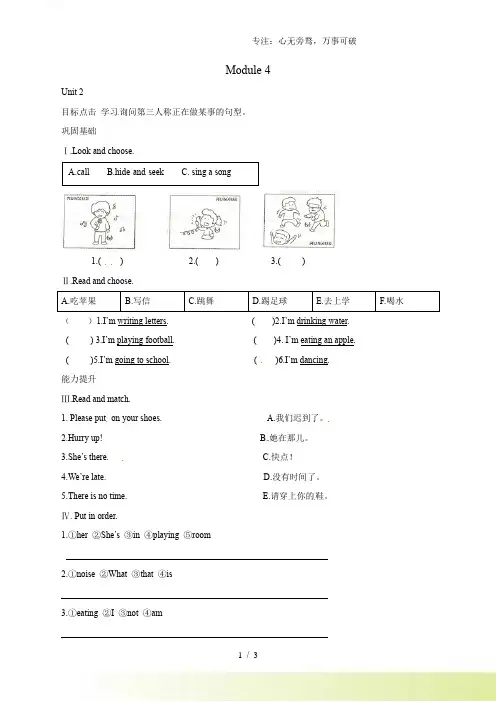
Module 4Unit 2目标点击学习询问第三人称正在做某事的句型。
巩固基础Ⅰ.Look and choose.A.callB.hide-and-seekC. sing a song1.( )2.( )3.( )Ⅱ.Read and choose.A.吃苹果B.写信C.跳舞D.踢足球E.去上学F.喝水()1.I’m writing letters. ( )2.I’m drinking water.( ) 3.I’m playing football. ( )4. I’m eating an apple.( )5.I’m going to school. ( )6.I’m dancing.能力提升Ⅲ.Read and match.1. Please put on your shoes. A.我们迟到了。
2.Hurry up! B.她在那儿。
3.She’s there. C.快点!4.We’re late. D.没有时间了。
5.There is no time. E.请穿上你的鞋。
Ⅳ. Put in order.1.①her ②She’s ③in ④playing ⑤room2.①noise ②What ③that ④is3.①eating ②I ③not ④am4.①cake ②Please ③your ④finishⅤ. Read and choose.( )1.What’s she doing?A.She is reading books.B.She is at school.C.She is a pupil.( )2.Where is Linda?A. She is playing the piano.B.She is there.C.She is going to school..( )3.Are you eating?A. No, I am not.B. Yes, you are.C. Yes, I is.( )4.What are you doing?A. You are drawing pictures.B. I go home.C. I’m talking.趣味练习Ⅵ. Read and circle the right answer.A.She’s a driver.B.They’re drinking.C.He’s eating.D.He’s there.E.Yes,it is.Module 4Unit 2巩固基础Ⅰ. 1.C 2.A 3.BⅡ. 1.B 2.F 3.D 4.A 5.E 6.C能力提升Ⅲ. 1—E 2—C 3—B 4—A 5—DⅣ.1.②④③①⑤ 2.②④③① 3.②④③① 4.②④③①Ⅴ.1.A 2.B 3.A 4.C趣味练习Ⅵ. C。
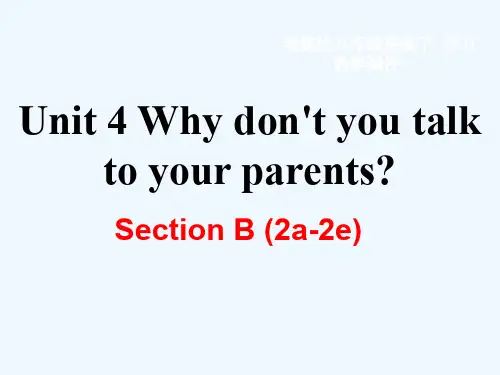
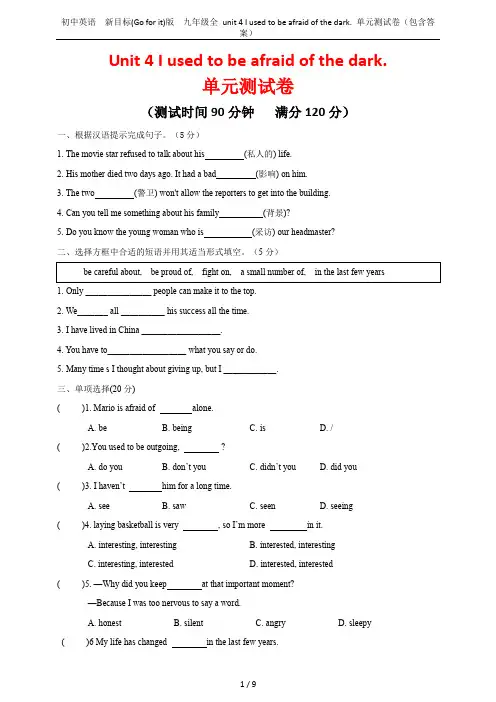
Unit 4 I used to be afraid of the dark.单元测试卷(测试时间90分钟满分120分)一、根据汉语提示完成句子。
(5分)1. The movie star refused to talk about his (私人的) life.2. His mother died two days ago. It had a bad (影响) on him.3. The two (警卫) won't allow the reporters to get into the building.4. Can you tell me something about his family (背景)?5. Do you know the young woman who is (采访) our headmaster?二、选择方框中合适的短语并用其适当形式填空。
(5分)1. Only _______________ people can make it to the top.2. We_______ all __________ his success all the time.3. I have lived in China __________________.4. You have to__________________ what you say or do.5. Many time s I thought about giving up, but I ____________.三、单项选择(20分)( )1. Mario is afraid of alone.A. beB. beingC. isD. /( )2.You used to be outgoing, ?A. do youB. don’t youC. didn’t youD. did you( )3. I haven’t him for a long time.A. seeB. sawC. seenD. seeing( )ying basketball is very , so I’m more in it.A. interesting, interestingB. interested, interestingC. interesting, interestedD. interested, interested( )5. —Why did you keep at that important moment?—Because I was too nervous to say a word.A. honestB. silentC. angryD. sleepy ( )6 My life has changed in the last few years.A. a lot ofB. lots ofC. a lotD. a lots of( )7. He’s always busy. And he working late until night.A. gets used toB. used toC. got used toD. is used for( )8. I used to a lot of time games with my friends.A. take, to playB. cost, playingC. spent, onD. spend, playing ( )9.Don’t shout at him like that. He is on ly a _____.A. eight-year-oldB. eight-years-oldC. seven-year-oldD. seven-years-old ( )10. To my _____, he failed the math exam again.A. surpriseB. surprisingC. surprisedD. surprises( )11. ---Is John in the classroom?---Maybe not. I saw him ________ the dining hall just now.A. enteringB. enterC. to enterD. entered( )12. It is ________ a beautiful garden ________ we like to play in it.A.so; that B.such; that C.too; to D.very; that( )13.—What ________ the number of the students in your school?—About two thousand. A number of them ________ from the countryside.A.is;are B.is;is C.are;is D.are;are( )14. He used to play basketball and he was _____ the school basketball team.A. onB. inC. atD. with( )15. The boss found two boys stealing his bread but he didn’t know _____A. how to do withB. what to do with themC. how to deal with itD. what to deal with ( )16. ________ used to ________ an old bookshelf in my room.A. There, beB. There, haveC. It, beD. There, having( )17. The math problem is so hard. I really don’t know ______.A. how to do itB. how to doC. what to do itD. what to do( )18. He doesn’t dare ______ her shyness.A. to faceB. facing withC. facel withD. facing( )19. Though the road __________ success is hard, you will _____it.A. of; succeedB. to; succeedC. of; makeD. to; make( )20. Although many people ever failed, they never _________ and managed to succeed.A. set outB. stayed upC. kept onD. gave up四、完形填空(10分)Mr. Black was over fifty years old. He sometimes made some mistakes in his work, and he lost his work. He had __1__ time every day to do something. Then he often met his old friends under a big tree. They had drunk there and __2__ anything they liked. One day, some old men were sitting together again and talking about the young people in this world. They all agreed that the old people were __3__ than the young people. Then one of the old __4__ said that the young men were stronger than the old men.__5__ o f them agreed that this was true, __6__ Mr. Black didn't. He said, “No, I am as strong now as when I was a young man.” His friends were surprised __7__ what he said.“Well,”said Mr. Black.“Near my house there is a big stone. When I was a young man, I used __8__ to move it, but I couldn't because I was not __9__.I am an old man now, and when I try to move it, I still__10__.So I am as strong as when I was young.”( )1.A.many B.a lot C.lots of D.lot( )2.A.talked for B.talked to C.talked with D.talked about( )3.A.clever B.cleverer C.cleverest D.a clever( )4.A.man B.woman C.men D.women( )5.A.All B.None C.Both D.Neither( )6.A.so B.or C.and D.but( )7.A.at B.to C.of D.on( )8.A.trying B.try C.to try D.to trying( )9.A.strong enough B.enough strong C.weak enough D.enough weak( )10.A.can B.can't C.could D.couldn't五、阅读理解(20分)AAs a student, I was most afraid to answer questions in class, and I found that the students around were just like me. At the beginning of each class, when the teacher asked a question, I always lowered my head because I was afraid that the teacher saw me.One day, in a foreign language class, Mr. Black gave us a lesson. He wanted us to be active in class, so he asked us some questions, but no one answered.“Let me tell you a story first,” he said.“When I came to the United States to study, the university often invited famous people to make speeches. Before the beginning of every speech, I found an interesting thing. The students around me always took a cardboard folded(折叠的)in half, wrote their names in bold with the most eye-catching color, andthen placed the cardboard on the seat. So when the speaker needed the answers from the students, he could see and call a listener's name directly.”“I couldn't understand that. My classmate told me the speakers were all top people, who meant chances. When your answer was to his surprise, it meant he might give you more chances. In fact, I really saw a few students got great chances because of that.”After listening to the story, I understood that the chance will not find you itself. You must show yourself all the time so that you can find a chance on the card.( )1.What did Mr. Black want the students to do in his class?A. Read loudly.B. Take notes carefully.C. Be active.D. Listen to him quietly.( )2.How did the writer's classmates behave when they were asked questions?A. They raised their hands.B. They shook their heads.C. They closed their eyes.D. They lowered their heads.( )3.How did the speaker get to know the students' names?A. He got them from the computer.B. He saw the cardboards on the seats.C. He asked the students for their names.D. He got them from the name list on the teacher's desk. ( )4.What does the underlined word “eye-catching” in Paragraph 3 mean?A.引人注目的B.眼睛疼痛的C.目光呆滞的D.泪眼蒙眬的( )5.What does the writer mainly tell us?A. Doing as others do is necessary.B. Answering questions bravely is easy.C. Attracting others' attention is interesting.D. Showing yourself bravely can win chances.BWhen I first came to New York, I didn't have many friends. I got upset easily. Luckily, one of my coworkers(同事), Erik, took great care of me. Actually, he changed me. I used to be shy. I had a hard time talking to strangers. Erik knew it. And he helped me deal with it.One day we were at a restaurant. I dropped a piece of pizza on my shirt while eating. Erik told me to borrow a Tide pen(去污笔) from someone. I was nervous, but Erik encouraged me. So I went to ask for help. In the end, I was not only able to clean my shirt, but also made friends with a stranger. It was a good start for me. I became more and more confident.Erik was optimistic about life. He always finds a way to change the bad things into something good. Because of a new job, I moved to a new city. Erik and I communicated with each other less and less. Then, one day, I got a call from a friend. Erik had passed away. It was one of the lowest moments in my life. Therewas nothing I could do to deal with my sorrow(悲伤) except going to sleep.I looked at a lot of videos about Erik. At t he end of one video, Erik said. “After the rain, the sun shines through the clouds.” I remembered Erik's optimism. Then I stopped crying. I decided to smile a bit wider and love life more.()6.From the first paragraph, we can learn that the writer ________.A.had many friends in New York B.was very happy to live in New YorkC.had a friendly coworker D.changed his friend's life()7.What is the third paragraph mainly about?A.Erik and the writer often had dinner out. B.Erik helped the writer deal with shyness.C.The writer was careless at dinner. D.The writer liked to make friends.()8.What does the underlined word “optimistic”mean in Chinese?A.悲观的B.乐观的C.敏感的D.迟钝的()9.What helped the writer get over his sad feelings?A.Erik's photos. B.A sunny day. C.Heavy rain. D.Erik's optimism.()10.Which of the following is TRUE about the change in the writer?A.Shy→confident. B.Noisy→quiet. C.Rude→polite. D.Dishonest→honest.六、句型转换(10分)1.His uncle used to be very thin.(改为否定句)His uncle______ ______ ______ be very thin.2.Carl has decided to take a guitar course during the summer vacation.(同义句)Carl has ________ ________ ________ to take a guitar course during the summer vacation.3. What a difficult problem it is! (改为同义句)___________ _________the problem is!4. Lin Tao seldom goes to the cinema.(对画线部分提问)________ _______does Lin Tao go to the cinema?七、用所给词的适当形式填空(10分)1. After hearing the words, the girl's face turned red because of ________(shy).2. It ________(be) three years since we last saw our primary school classmates.3. Mike's new classmate is a(n) ________(Africa) and he's from South Africa.4. Candy told me that she used to be really shy and took up ______(sing) to deal with her shyness.5. ________(hang) out with friends is almost impossible for me now.6. You really require a lot of talent and hard work ______( succeed).7. It’s hard _________(believe) that he used to have difficulties in school.8. The doctors can't say ________ (exact) what's wrong with my mother.9. To students,this book is ____________ (help) than that one.10. The man was interested in the ________ (introduce)about the book and decided to buy it.八、根据汉语完成句子(15分)1. 因为伤到了左腿,马特今天没来上学。
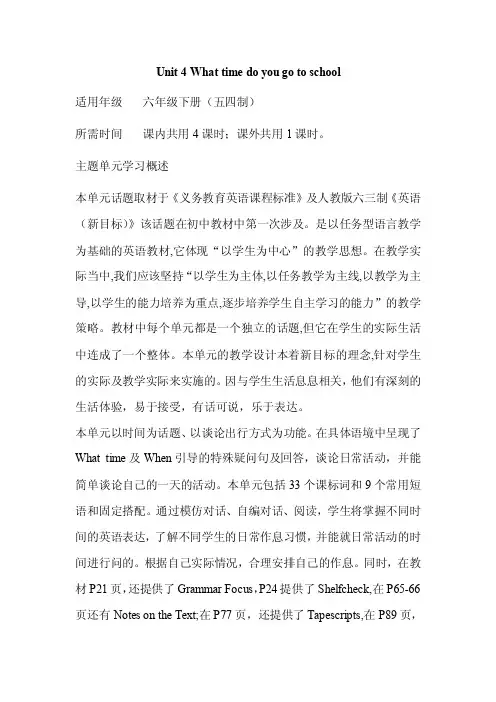
Unit 4 What time do you go to school适用年级六年级下册(五四制)所需时间课内共用4课时;课外共用1课时。
主题单元学习概述本单元话题取材于《义务教育英语课程标准》及人教版六三制《英语(新目标)》该话题在初中教材中第一次涉及。
是以任务型语言教学为基础的英语教材,它体现“以学生为中心”的教学思想。
在教学实际当中,我们应该坚持“以学生为主体,以任务教学为主线,以教学为主导,以学生的能力培养为重点,逐步培养学生自主学习的能力”的教学策略。
教材中每个单元都是一个独立的话题,但它在学生的实际生活中连成了一个整体。
本单元的教学设计本着新目标的理念,针对学生的实际及教学实际来实施的。
因与学生生活息息相关,他们有深刻的生活体验,易于接受,有话可说,乐于表达。
本单元以时间为话题、以谈论出行方式为功能。
在具体语境中呈现了What time及When引导的特殊疑问句及回答,谈论日常活动,并能简单谈论自己的一天的活动。
本单元包括33个课标词和9个常用短语和固定搭配。
通过模仿对话、自编对话、阅读,学生将掌握不同时间的英语表达,了解不同学生的日常作息习惯,并能就日常活动的时间进行问的。
根据自己实际情况,合理安排自己的作息。
同时,在教材P21页,还提供了Grammar Focus,P24提供了Shelfcheck,在P65-66页还有Notes on the Text;在P77页,还提供了Tapescripts,在P89页,提供了语音练习,含字母及字母组合的常见发音及句子重音两部分。
本单元的学习重、难点: (1)语言技能方面:通过听录音,运用抓关键词的听力学习策略获取有效信息。
通过观看PPT呈现的图片及题目预测本单元的知识点。
将使用的特殊疑问句及相关回答运用所学与同伴就上学、外出、走亲访友的话题进行口头交流;能运用所学写一篇介绍自己平时作息的小短文(50词左右)。
(2)语言知识方面:33个课标词和9个常用短语和固定搭配;Grammar Focus中的句型以及介绍自己一天生活作息的相关句子。


班级_____________ 姓名_____________ 座号____________人教新起点小学英语二年级下册Unit 4 TimeStory time习题一、看图,读句子,判断对错,用“√”或“×”表示。
It’s eleven twelve.It’s eleven thirty.It’s eleven fifty.()()()Let’s fly the kite.Let’s play football.Let’s ride the bike.()()()二、选出不同类的一项。
()1.A.play B.kite C.fly()2.A.football B.thirty C.forty()3.A.fifty B.ten C.swim()4.A.time B.eleven C.twelve三、读句子,选中文,填字母编号。
()1.What time is it? A.我们踢足球吧。
()2.Let’s start. B.我们放风筝吧。
()3.Let’s play football. C.几点了?()4.Let’s fly the kite. D.噢,真的吗?()5.Let’s ride the bike. E.我迟到了。
()6.Oh, really? F.我赢了!()7.I’m late. G.我们骑自行车吧。
()8.I win! H.我们开始吧。
人教新起点小学英语二年级下册Unit 4 TimeStory time习题答案一、看图,读句子,判断对错,用“√”或“×”表示。
×√√××√二、选出不同类的一项。
1-4.B A C A三、读句子,选中文,填字母编号。
1-4.C H A B5-8.G D E F。
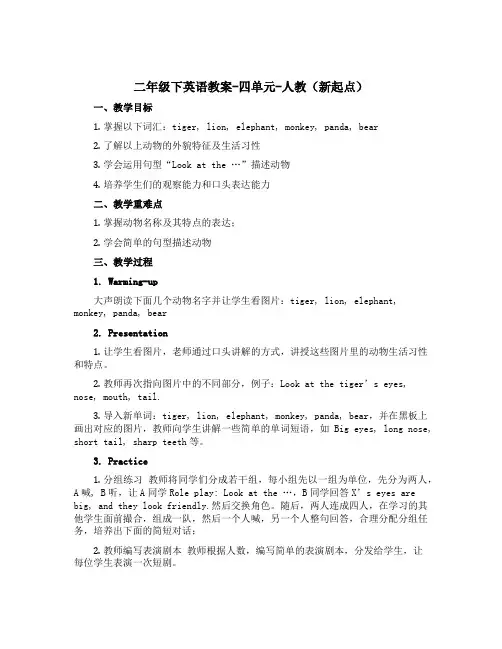
二年级下英语教案-四单元-人教(新起点)一、教学目标1.掌握以下词汇:tiger, lion, elephant, monkey, panda, bear2.了解以上动物的外貌特征及生活习性3.学会运用句型“Look at the …”描述动物4.培养学生们的观察能力和口头表达能力二、教学重难点1.掌握动物名称及其特点的表达;2.学会简单的句型描述动物三、教学过程1. Warming-up大声朗读下面几个动物名字并让学生看图片:tiger, lion, elephant, monkey, panda, bear2. Presentation1.让学生看图片,老师通过口头讲解的方式,讲授这些图片里的动物生活习性和特点。
2.教师再次指向图片中的不同部分,例子:Look at the tiger’s eyes, nose, mouth, tail.3.导入新单词:tiger, lion, elephant, monkey, panda, bear,并在黑板上画出对应的图片,教师向学生讲解一些简单的单词短语,如Big eyes, long nose, short tail, sharp teeth等。
3. Practice1.分组练习教师将同学们分成若干组,每小组先以一组为单位,先分为两人,A喊, B听,让A同学Role play: Look at the …,B同学回答X’s eyes are big, and they look friendly.然后交换角色。
随后,两人连成四人,在学习的其他学生面前撮合,组成一队,然后一个人喊,另一个人整句回答,合理分配分组任务,培养出下面的简短对话;2.教师编写表演剧本教师根据人数,编写简单的表演剧本,分发给学生,让每位学生表演一次短剧。
4. Extension1.让学生在课间时间画出他们最感兴趣的一只动物,然后在课堂上展示给全班看;2.学生们可以在家里完成相关的作业,如用拼布或画笔画出他们最喜欢的一种动物,或者是填写根据提示绘制出的动物外貌特征表格(如生活习性、食性、生息地等)。
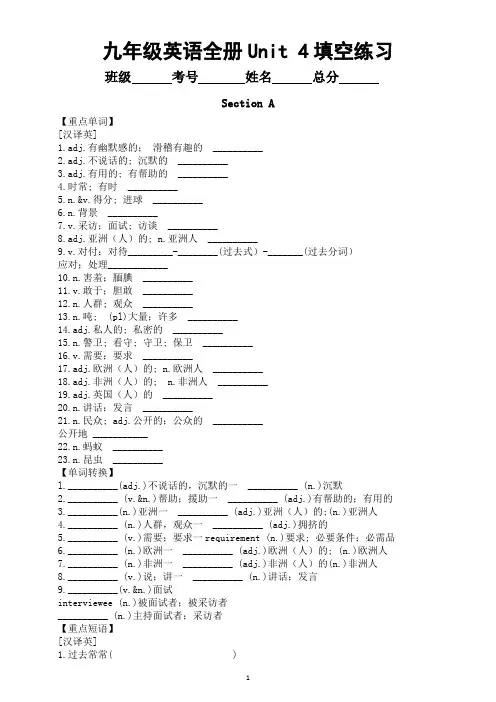
九年级英语全册Unit 4填空练习班级考号姓名总分Section A【重点单词】[汉译英]1.adj.有幽默感的;滑稽有趣的 __________2.adj.不说话的; 沉默的 __________3.adj.有用的; 有帮助的 __________4.时常; 有时 __________5.n.&v.得分; 进球 __________6.n.背景 __________7.v.采访;面试; 访谈 __________8.adj.亚洲(人)的; n.亚洲人 __________9.v.对付:对待_________-________(过去式)-_______(过去分词)应对;处理____________10.n.害羞;腼腆 __________11.v.敢于;胆敢 __________12.n.人群; 观众 __________13.n.吨; (pl)大量;许多 __________14.adj.私人的; 私密的 __________15.n.警卫; 看守; 守卫; 保卫 __________16.v.需要;要求 __________17.adj.欧洲(人)的; n.欧洲人 __________18.adj.非洲(人)的; n.非洲人 __________19.adj.英国(人)的 __________20.n.讲话:发言 __________21.n.民众; adj.公开的;公众的 __________公开地 ___________22.n.蚂蚁 __________23.n.昆虫 __________【单词转换】l.__________(adj.)不说话的,沉默的一 __________ (n.)沉默2.__________ (v.&n.)帮助;援助一 __________ (adj.)有帮助的;有用的3.__________(n.)亚洲一 __________ (adj.)亚洲(人)的;(n.)亚洲人4.__________ (n.)人群,观众一 __________ (adj.)拥挤的5.__________ (v.)需要;要求一requirement (n.)要求; 必要条件;必需品6.__________ (n.)欧洲一 __________ (adj.)欧洲(人)的; (n.)欧洲人7.__________ (n.)非洲一 __________ (adj.)非洲(人)的(n.)非洲人8.__________ (v.)说;讲一 __________ (n.)讲话;发言9.__________(v.&n.)面试interviewee (n.)被面试者;被采访者__________ (n.)主持面试者;采访者【重点短语】[汉译英]1.过去常常( )3.看到某人正在做某事( )2.时常; 有时( )5.应对; 处理( )4.学着做; 开始做( )7.在前面( )6.不再;再也不( )9.许多; 大量( )8.做演讲( )1l.闲逛( )10.当心; 小心( )13.获得成功( )l2.许多:大量( )14.公开地 ( )【重点句型】1.Mario,you ______________ short,didn't you?马里奥,你过去很矮,是吗?2.________ he ________ now? 他现在长什么样?3.The party is ______________________________!(举办)这次聚会的主意实在太棒了!4.__________________ three years since we last saw our primary school classmates.我们已经有三年没见我们的小学同学了。
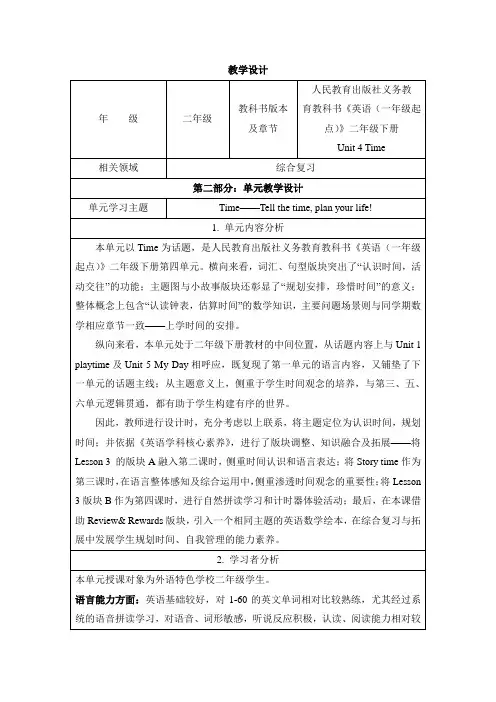
教学设计第三部分:课时教学设计课题Save time, plan your life!1. 指导思想与理论依据《英语课程标准》(2011版)强调语言学习的实践性和应用性,主张学生在语境中接触、体验和理解真实语言,鼓励学生通过体验、实践、探究等方式,发现语言规律,形成学习策略,发展自主学习能力。
这也正是英语学科核心素养所倡导的,即培养学生的“思维品质”(包括分析、判断等活动)和“学习能力”(如自主管理等)。
深度学习理念则将以上理论思想细化为具体条件,如学生主动参与;确立高阶思维发展的教学目标;整合意义联接的学习内容;创设真实情境及持续关注的评价方式。
因此,以不同任务激发学生主动参与发现、解决问题,从而发展自主管理能力;以合作探究引导学生发现语言规律,从而形成一定的思维品质;以真实情境整合学习内容及评价方式的意义联结,是设计本节课的基本理念。
基于上述理论依据,本课以“时间规划”为内容依托,通过绘本故事的阅读,使学生在帮助故事人物解决问题的过程中,复习再现“认识时间”的语言知识,在律,尤其是“几十”和“十几”的表达,并能类推到百以内数字单词,进而可以表达所有的时间(几点几分)2. 能够在故事情境中综合运用功能句型“What time is it'?"Its.”,并能够拓展Let's..”进行晨间活动的表达。
3. 能结合故事情境及讨论分享,理解“time line”(时间段)的概念,将“珍惜时间”的认知经验具体化为“如何”节约时间、合理规划,培养自我管理能力。
教学难点:1. 能结合故事情境及讨论分享,理解“tie1ine”(时间段)的概念,将“珍惜时间”的认知经验具体化为“如何”节约时间、合理规划,培养自我管理能力。
5. 教字过程与教学资源设计(可附教学流程图,含板书设计)教学流程教学过程Before-reading读前热身,复习导入1. 游戏猜谜,激趣热身,聚焦主题,复习旧知师生问候。
人教版新目标七年级英语下册 Unit 4 教学设计一. 教材分析人教版新目标七年级英语下册Unit 4主要围绕日常生活中的交通工具展开。
本单元通过介绍不同交通工具的特点和使用场景,让学生学会表达各种交通工具的名称和用途,以及如何描述交通工具的特点。
教材包括听力、口语、阅读和写作等方面的内容,旨在提高学生的综合语言运用能力。
二. 学情分析七年级的学生已经掌握了基本的英语语法和词汇,具备一定的听说读写能力。
但部分学生对英语学习仍存在恐惧心理,不敢开口说英语。
此外,学生对日常生活中的交通工具较为熟悉,但如何用英语表达交通工具的特点和用途仍需加强。
三. 教学目标1.知识目标:学生能够掌握有关交通工具的词汇和表达方式,如bus,trn, car, subway等,以及描述交通工具特点的句子结构。
2.能力目标:学生能够用英语进行简单的日常交流,如询问和介绍交通工具的名称、用途和特点。
3.情感目标:培养学生热爱生活,关注环境保护的意识。
四. 教学重难点1.重点:交通工具的词汇和表达方式,以及句子结构的运用。
2.难点:如何准确描述交通工具的特点和用途。
五. 教学方法采用任务型教学法、情境教学法和交际教学法,以学生为主体,教师为主导,通过听力、口语、阅读和写作等多种活动,让学生在实际情境中感知、理解和运用语言。
六. 教学准备1.准备相关交通工具的图片、视频等教学资源。
2.设计听力、口语、阅读和写作等教学活动。
3.准备黑板、粉笔等教学工具。
七. 教学过程1.导入(5分钟)利用图片或视频展示不同交通工具,引导学生谈论交通工具的名称和用途。
2.呈现(10分钟)呈现本节课的主要内容,包括交通工具的词汇和表达方式,以及描述交通工具特点的句子结构。
3.操练(15分钟)通过听力、口语、阅读和写作等多种活动,让学生在实际情境中感知、理解和运用语言。
1)听力活动:播放一段关于交通工具的录音,学生听后回答问题。
2)口语活动:学生分组讨论,用英语介绍自己喜欢的交通工具。
人教新起点二年级下册英语-Unit 4 Storytime教案教学目标1.学习Vocabulary: bedroom, bathroom, living room, kitchen, dining room, ask and answer 教室用具。
2.听力训练,培养学生的听力能力和口语表达能力。
3.提高学生英语阅读能力,培养学生的阅读习惯。
4.进一步丰富学生英语知识,促进他们英语综合能力的发展。
教学准备1.多媒体课件2.单词卡片3.PPT练习题教学过程Step 1 Warming up1.Greetings。
询问学生的假期状态。
2.Review。
通过猜字谜的方式询问家庭用具。
Step 2 Presentation1.Introduce vocabulary。
在教室内展示各个房间的图片,学生说出对应的英文。
强调单词发音和图像的对应关系。
2.Listen and match。
播放录音,学生听到录音中的家具后,匹配相应的家具图片。
Step 3 Practice1.Ask and answer。
学生自己示范问与答,老师强调语音和语调。
2.Group work。
以组为单位,进行对话练习。
3.Pair work。
提供画有房间布置的图片,两个学生互相描述对方画的图片中的家具。
Step 4 Production1.Storytime。
老师通过熟悉的故事,引导学生去学习和表述家庭用具。
2.Fill in the blanks。
以填空的方式检查学生是否理解和记忆这些家庭用具。
Step 5 Extension1.PPT课件交互练习。
2.Homework。
抄写单词。
教学反思本节课采用了多种教学方法,如听力训练、口语练习、小组合作学习。
在课堂上学生的表现积极,学习效果良好。
但是,在学生的表现中出现了一些问题,如学生的发音不准确,理解没跟上。
在后续的教学中需要重点提醒学生发音和重复掌握一些基本的单词。
在课堂结束时对运用课堂时间情况,老师总结课程的主要内容,总结教学效果和学生反馈,以便下一次课堂的教学改进。
二年级下册英语教学设计-Module 4 Unit 2 What’s he doing外研社(一起)教学目标1.学生能够掌握词汇:doing homework,playing football,swimming,eating,reading,watching TV,drawing,singing,dancing;2.学生能够理解句型What’s he doing? 和回答He’s…;3.学生能够通过图画和课堂互动说出人物正在做的事情。
教学准备1.多媒体PPT;2.单词卡片;3.各种场景图片。
教学过程Step 1. 导入新课1.导入课程前,通过整合学生的关于主题的现有知识,老师调动学生的兴趣,如提问:What are you doing now?(你现在在干什么?)2.通过展示图片介绍新的单词,并通过重复使学生牢记单词要素;3.通过示范/模仿使学生听懂句型What’s he doing?(他在做什么?)和回答He’s…(他在…)。
Step 2. 学习新单词1.学生首先观察图片,让他们猜出每个单词;2.通过多次重复诵读单词,使学生掌握新单词;3.通过示范/模仿呈现单词,让学生说出句型What’s he doi ng? 和回答He’s…。
Step 3. 了解句型What’s he doing?1.通过展示图片让学生说出人物正在做的事情,然后引出句型What’s he doing?;2.将问题传递给其他同学。
Step 4. 了解回答He’s…1.通过展示图片,鼓励学生用He’s…完成一些动作,比如He’s playing football,He’s drawing;2.引导每个学生回答问题。
Step 5. 讨论和练习1.让学生在小组中共享自己的日常活动,问问题 What are you doing?;2.通过模仿和角色扮演练习句型What’s he doing? 和回答He’s…。
Step 6. 总结1.让学生观看PPT,回顾今天的课程;2.总结新的单词和句型,让学生重复每个词/短语/句子,法使他们获得正确的单词和句型;总结这个教学设计主要集中在学生能够理解和掌握新的单词和句型What’s he doing? 和回答He’s…. 教学过程大致分为導入、学习新单词、掌握句型、讨论和练习等步骤,中间穿插小组合作和角色扮演。
人教新起点二年级下册英语-Unit 4 Lesson 2导学案一、学习目标1.学习掌握单词:count, young, old, dance,了解它们的意思和拼写。
2.能够使用英语句子简单谈论年龄和能力。
3.能够参与英语的对话,和其他同学交流。
二、课前准备1.学习和复习上一课时的学习内容,包括单词、句型等。
2.预习本节课的学习内容,了解本节课的单词和句型。
3.准备好课本和笔记工具。
三、课堂学习1. 钟爱动作在本节课前,老师可提前准备一个钟表,让同学们依次转动指针,同学们在指针指向自己时,说出一个动作,其他同学都要跟随这个动作。
这个环节的目的是让孩子们在轻松的气氛下练习英语的口语表达。
2. 听力练习播放录音并跟随录音,读出已经学过的单词和句型。
录音内容:A: How old are you, Daming?B: I’m eight years old. How old are you?A: I’m eleven. Can you count to twenty in English?B: Yes, I can. Can you dance?A: No, I can’t. Can you dance?B: Yes, I can.练习内容:1.听录音并跟读:How old are you, Daming?I’m eight years old. How old are you?I’m eleven.Can you count to twenty in English?Yes, I can.Can you dance?No, I can’t.Can you dance?Yes, I can.2.做完听力练习后,同学们可以互相交流自己和伙伴的年龄,以及是否能够跳舞。
3. 语言点梳理1. 年龄的表达询问别人的年龄:•How old are you?•What’s your age?回答自己的年龄:•I’m (number) years old.回答别人的年龄:•He/She is (number) years old.2. 能力的表达询问别人的能力:•Can you (动作)?回答自己的能力:•Yes, I can.•No, I can’t.回答别人的能力:•He/She can (动作)。
二年级下册英语教案-Unit 4 Time Lesson 1 (2)∣人教新起点一、教学目标1.能够听、说、认读数字“1-12”及词汇:one o’clock、two o’clock、three o’clock、four o’clock、five o’clock、six o’clock、 seveno’clock、eight o’clock、nine o’clock、ten o’clock、eleven o’clock、twelve o’clock。
2.能够理解和运用句型What time is it? It’s … 与他人交流问答时间。
二、教学重点1.数字1-12及词汇one o’clock、two o’clock、three o’clock、four o’clock、five o’clock、six o’clock、seven o’clock、eight o’clock、nine o’clock、ten o’clock、eleven o’clock、twelve o’clock。
2.句型What time is it? It’s …结构的理解和应用。
三、教学难点1.数字和词汇的识别及正确发音。
2.句型Wh at time is it? It’s …结构的套用和应用。
四、教学步骤1. Warm-up1.Greet the students, and ask a student to lead the class in a brief warm-up exercise.2.Review the previous lesson, Unit 4 Time Lesson 1 (1).2. Presentation1.Review the numbers from 1 to 12, and help the students learn the new vocabulary: one o’clock, two o’clock, etc. by repeating after the teacher.2.Introduce the sentence “What time is it?” and practice asking and answering with it.3. Practice1.Play a time-telling game with the class. The teacher can ask individual students,。
九年级英语全册Unit 4知识点SectionA【重点语块】1.straight hair直发2.curly hair卷发3.get good grades/scores取得好成绩4.cultural background文化背景5.get tons of/a lot of attention被众人所关注;吸引无数目光6.be afraid of the dark怕黑7.keep silent保持沉默8.give a speech in public在公共场合发表演讲9.in front of crowds在人群面前10.private time私人时间11.a humorous teacher一个幽默的老师12.take up doing sth.开始做某事;学着做某事13.dare to do sth.敢于做某事14.how to deal with / what to do with the problem 怎样处理这个问题15.what I say or do我所说的话或所做的事16.guard our motherland保卫我们的祖国17.give up the plan放弃这个计划18.require sb.to do sth.要求某人做某事19.fight on奋力坚持下去20.make it to the top成功到达顶峰21.from time to time时常;有时22.hang out with friends与朋友们外出23.all the time一直24.everywhere I go我去的每个地方ed to be shy过去很害羞26.read books on European history阅读关于欧洲历史的书27.have an interview有一个面试28.an Asian singer一名亚洲歌手29.the road to success成功之路30.be helpful for my study有助于我的学习【词形变换】1.appear v.出现→appearance n.出现;外貌→disappear v.消失→disappearance n.消失;失踪2.personality n.性格→personal adj.个人的;私人的→person n.人3.humorous adj.有幽默感的;滑稽有趣的→humor n.幽默4.silent adj.不说话的;沉默的→silence n.沉默→silently adv.沉默地5.helpful adj.有用的;有帮助的→helpless adj.无助的→help v.&n.帮助6.interview v./n.采访;面试→interviewer n.采访者;(面试)主考官→interviewee n.被采访者;参加面试者7.shyness n.害羞→shy adj.害羞的8.require v.需要;要求→requirement n.需要;要求 n.亚洲→Asian adj.亚洲(人)的n.亚洲人10.Europe n.欧洲→European adj.欧洲(人)的n.欧洲人11.Africa n.非洲→ African adj.非洲(人)的,n.非洲人12.Britain n.英国→British adj.英国(人)的,n.英国人13.public adj.公开的;公众的→publicly adv.公开地【重点句子】1.I used to be afraid of the dark.我过去怕黑。